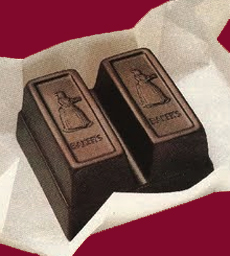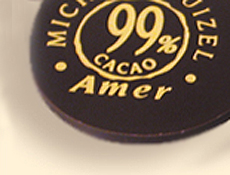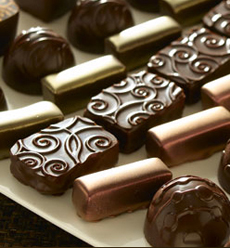
All chocolate comes from cacao beans. Photo courtesy of Amano Chocolate, a NIBBLE Top Pick Of The Week.
Last Updated May 2018 |
Product Reviews / Main Nibbles / ChocolateChocolate GlossaryTerms & Definitions: Belgian Chocolate & Other Terms With “B”
On this page you’ll find terms like Baker’s chocolate, Belgian chocolate and bloom. If you think we should consider chocolate terms and definitions other than those we have provided, or you’d like to suggest additional words for inclusion, click on the Contact Us link on this page. Also enjoy our many other food glossaries. Click on a letter to go to the appropriate glossary page. a b c d e f g h i j k l m n o p q r s t u v w x y z This glossary is protected by copyright and cannot be reproduced in whole or part.
BAKER’S CHOCOLATE or BAKING CHOCOLATE or BITTER CHOCOLATE or UNSWEETENED CHOCOLATE
NOTE: Greater Boston was the site of the first U.S. chocolate factories: in 1765 an Irish chocolate-maker, John Hannan, put up a mill on the site of an old powder mill in Milton and imported cocoa beans from the West Indies to produce cakes of ground cacao bean paste used to make drinking chocolate. Other ventures sprouted up in the area. In 1780, Harvard graduate, teacher, and medical student James Baker saw the possibilities of the chocolate business and went into it with great success, producing the now-famous BAKER’S brand of chocolate. For the complete story, visit the Dorchester Atheneum. The brand is now owned by Kraft. BAIN-MARIE BALLOTINA ballotin is a box developed in Belgium with structured compartments designed to prevent the chocolates from crushing each other. Unlike boxes that hold chocolate in ridged paper cups, chocolates in ballotins cannot move from their designated compartments. Ballotins are of elegant design, befitting its contents. The ballotin was invented in 1912 by Louise Agostini, whose husband was a grandson of the founder of Neuhaus Chocolates. BÂTONA French term for a slim bar of chocolate, a specialty size differentiated from a regular eating bar, which is called a tablette. BEANAlso called the grain, the seed of the cacao pod of the Theobroma cacao tree, beans are the source of all chocolate and cocoa. There are generally 20 to 40 flat, almond-shaped beans in a pod, depending on the species. When first picked, the beans have tropical flavors of lychee and pineapple; but in a few hours the sugars convert and they become bitter and inedible. Beans are then fermented, dried, roasted, ground and conched to create chocolate. All cacao is grown in tropical rainforests; almost all of these are in third world countries. Producers of chocolate purchase the beans through brokers who are on the ground in the countries of origin. Some cacao beans are purchased directly from small cooperatives of growers, others from individual farms, and in some countries, such as Ghana, the beans must be bought through a country’s Cacao Board.
BEAN TO BARThis term refers to a chocolate maker who makes chocolate from scratch, starting with selection of raw cacao beans. The beans are then roasted and turned into couverture, the large blocks of chocolate which are then melted and used to make chocolate products—bars, bonbons, etc. Here is the chocolate production process. The alternative is to purchase ready-made couverture chocolate. BELGIAN or BELGIAN-STYLE CHOCOLATEOf the three styles of bonbons—Belgian, French and Swiss—Belgian chocolates are characterized by a slightly larger size, a thicker chocolate shell and a heavier and sweeter ganache. Belgian chocolates are made in molds, accounting for the thicker shell. The technique of molding was created by Belgian chocolatier Jean Neuhaus in 1912, who developed a process to pour couverture into molds creating a hard shell, enabling softer, more liquid fillings like cremes, to be used. Prior to then, firm centers like caramels, jellies and thick ganaches were hand-dipped into the couverture. Some Belgian chocolatiers also use cookie pieces when creating certain chocolates. (Pierre Marcolini, who is also a patissier, does some wonderful pieces with cookies; although Marcolini, a Belgian, actually makes French-style chocolates). BITTER CHOCOLATEAnother word for Baker’s chocolate or unsweetened chocolate. BITTERSWEET CHOCOLATE
BLENDED BARA chocolate bar made of beans representing any combination of bean varieties, growing regions, and harvest years. The opposite of a blended bar is a single origin bar, where all of the beans come from the same area; or a grand cru bar, where all of the beans come from the same plantation or estate. Blended bars are sometimes called “house bars” because they are blended to a consistent recipe year after year to represent the house style of the producer. BLENDINGThe process that takes place with chocolate that is not single bean, e.g. 100% Porcelana—i.e., most chocolate. After roasting and before grinding, the crushed cacao beans are blended in a formula or “recipe” determined by the master blender, to determine the flavor of the finished chocolate. Since even beans from the same region can vary in flavor from harvest to harvest—acidic, fruity, earthy, sweet, bitter, spicy, woody etc.—the blending process, along with the flavoring process, produces a consistent “house style.” BLOOMThere are two kinds of bloom that form on the surface of chocolate: Both are temperature-related and both make the chocolate look suspect and unappetizing. With fat bloom or cocoa butter bloom, the chocolate loses its gloss: A powdery grayish-white or tan film forms on the surface. This is due to improper storage, poorly tempering, lack of tempering, or changes in temperature. Heating chocolate above 70°F, as well as repetitive heating and cooling, will cause microscopic cocoa butter particles to join together, leaving particles of sugar and cocoa uncoated. The bloom is the cocoa butter that has separated and risen to the surface. In some cases the chocolate may become soft or crumbly. While bloom diminishes the appearance of the chocolate, it does not alter the taste and is not harmful. Chocolate with fat bloom can be eaten although it may taste drier. Fat bloom can be avoided by storing chocolate a constant temperature. Sugar bloom is caused by condensation, due to excessive moisture. The moisture combines with the sugar in the chocolate to create a syrup. Large sugar crystals remain on the surface of the chocolate when the moisture evaporates. See sugar bloom for more information.
BOUCHONA bouchon (BOO-shone) French for cork, is a molded, cork-shaped chocolate. It can be solid or filled. BOUTIQUE CHOCOLATIEROften the term “boutique chocolatier” is substituted for artisan chocolatier, but they are different. While an artisan sells his/her handmade wares in a small shop, or boutique, anyone with no skills can open a shop or “boutique” that sells chocolate purchased from elsewhere, that is not necessarily handmade or or artisan quality. (In fact, companies like Hershey’s have chocolate boutiques—shops that sell only their products.)
BRUT or BAKER’S CHOCOLATEAn FDA classification of chocolate that does not contain any sugar, though it may contain flavoring like vanilla. This pure chocolate was initially intended intended for cooking but today fine 100% cacao chocolate is enjoyed by many. See baker’s chocolate. BUTTERFAT or BUTTER FAT or MILKFATThe natural fat in milk from which butter is made; it is separable from the milk by churning. There is no butterfat in cocoa butter, which is a vegetable product. The French word for butterfat is graisse butyrique. BUTTER OILClarified butter, used instead of more expensive cocoa butter in some chocolate formulations to create a smoother texture and mouthfeel.
Continue To Next Page: Chocolate Terms With C
Lifestyle Direct, Inc. All rights reserved. Images are the copyright of their respective owners.
|
Last Updated May 2018
© Copyright 2005-2025 Lifestyle Direct, Inc. All rights reserved. All images are copyrighted to their respective owners.


